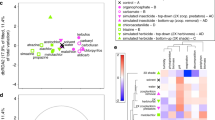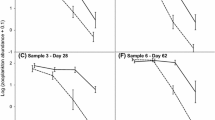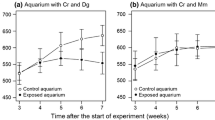Abstract
Ecosystems are subject to a combination of recurring anthropogenic and natural disturbances, such as climate change and pesticide exposure. Biological communities are known to develop tolerance to recurring disturbances due to successive changes at both the community and organismal levels. However, information on how additional stressors may affect the development of such community tolerance is scarce to date. We studied the influence of hydrological disturbance on the reaction of zooplankton communities to repeated insecticide pulses in outdoor microcosms. The communities were exposed to three successive pulses of the insecticide esfenvalerate (0.03, 0.3, and 3 µg/L) and to the gradual removal of water and its subsequent replacement over three cycles or to a constant water level. Except at the highest esfenvalerate concentration, the communities developed tolerance to the toxicant, as indicated by their decreasing reaction to subsequent insecticide applications, and this development was enhanced by hydrological disturbance. The pronounced decline of the key taxa Daphnia spp. through the combined action of the two stressors was identified as the main mechanism responsible for the increase in community tolerance under a fluctuating water level. Under a constant water level, the abundance of Daphnia spp. did not decrease significantly without the insecticide treatment, indicating that other mechanisms were responsible for the observed community tolerance. The present study shows that additional stressors can facilitate the development of community tolerance and that such facilitation is propagated through community-level mechanisms.





Similar content being viewed by others

References
Anderson BG, Jenkins JC (1942) A time study of events in the life span of Daphnia magna. Biol Bull Mar Biol Lab Woods Hole 83:260–272
Bacey J, Spurlock F, Starner K, Feng H, Hsu J, White J, Tran DM (2005) Residues and toxicity of esfenvalerate and permethrin in water and sediment, in tributaries of the Sacramento and San Joaquin rivers, California, USA. Bull Environ Contam Toxicol 74:864–871
Beketov MA, Kefford BJ, Schäfer RB, Liess M (2013) Pesticides reduce regional biodiversity of stream invertebrates. PNAS 110:11039–11043
Bérard A, Dorigo U, Humbert JF, Leboulanger C, Seguin F, (2002) La méthode PICT (Pollution-Induced Community Tolerance) appliquée aux communautés algales: intérêt comme outil de diagnose et d’évaluation du risque écotoxicologique en milieu aquatique. In Ann Limnol—Int J Lim 38, 247–261. EDP Sciences
Blanck H, Wängberg S, Molander S (1988) Pollution-induced community tolerance. A new ecotoxicological tool. In: Pratt J Jr, Cairns JR (eds) Functional testing of aquatic biota for estimating hazards of chemicals. American Society for Testing Materials, Philadelphia, pp 219–230
Boivin MEY, Massieux B, Breure AM, van den Ende FP, Greve GD, Rutgers M, Admiraal W (2005) Effects of copper and temperature on aquatic bacterial communities. Aquat Toxicol 71:345–356
Boone MD, Bridges CM, Rothermel BB (2001) Growth and development of larval green frogs (Rana clamitans) exposed to multiple doses of an insecticide. Oecologia 129:518–524
Clements WH (1999) Metal tolerance and predator-prey interactions in benthic macroinvertebrate stream communities. Ecol Appl 9:1073–1084
Cooper C, Smith S, Moore M (2003) Surface water, ground water and sediment quality in three oxbow lake watersheds in the Mississippi Delta agricultural region: pesticides. Int J Ecol Environ Sci 29:171–184
Coops H, Beklioglu M, Crisman TL (2003) The role of water-level fluctuations in shallow lake ecosystems—workshop conclusions. Hydrobiologia 506–509:23–27
Daam MA, Van den Brink PJ, Nogueira AJA (2008) Impact of single and repeated applications of the insecticide chlorpyrifos on tropical freshwater plankton communities. Ecotoxicology 17:756–771
Development Core Team R (2009) R: A language and environment for statistical computing. R Foundation for Statistical Computing, Vienna
DeVries DR, Stein RA (1991) Comparison of three zooplankton samplers: a taxon-specific assessment. J Plankton Res 13:53
Field JG, Clarke KR, Warwick RM (1982) A practical strategy for analysing multispecies distribution patterns. Mar Ecol Prog Ser 8:37–52
Giraudoux P (2009) Pgirmess: Data analysis in ecology. R package version 1.4.9. Online at: http://CRAN.R-project.org/package=pgirmess
Hanazato T, Yasuno M (1990) Influence of time of application of an insecticide on recovery patterns of a zooplankton community in experimental ponds. Arch Environ Contam Toxicol 19:77–83
IPCC (2012) Managing the risks of extreme events and disasters to advance climate change adaptation, a special report of working groups I and II of the Intergovernmental Panel on Climate Change [Field CB, Barros V, Stocker TF Qin D, Dokken DJ, Ebi KL, Mastrandrea MD, Mach KJ, Plattner G-K, Allen SK, Tignor M, and Midgley PM (Eds)], Cambridge, p 582
Jansen M, Coors A, Stoks R, De Meester L (2011) Evolutionary ecotoxicology of pesticide resistance: a case study in Daphnia. Ecotoxicology 20:543–551
Kattwinkel M, Kühne J, Foit K, Liess M (2011) Climate change, agricultural insecticide exposure, and risk for freshwater communities. Ecol Appl 21:2068–2081
Knillmann S, Stampfli NC, Noskov YA, Beketov MA, Liess M (2013) Elevated temperature prolongs long-term effects of a pesticide on Daphnia spp. due to altered competition in zooplankton communities. Global Change Biol 19:1598–1609
Leps J, Smilauer P (2003) Multivariate analysis of ecological data using CANOCO. Cambridge University Press, Cambridge
Liess M, Beketov M (2011) Traits and stress: keys to identify community effects of low levels of toxicants in test systems. Ecotoxicology 20:1328–1340
Liess M, Schäfer RB, Schriever CA (2008) The footprint of pesticide stress in communities—species traits reveal community effects of toxicants. Sci Total Environ 406:484–490
Liess M, Schulz R, Liess M-D, Rother B, Kreuzig R (1999) Determination of insecticide contamination in agricultural headwater streams. Water Res 33:239–247
Millennium Ecosystem Assessment (2005) Ecosystems and human well-being: current state and trends: findings of the condition and trends working group. In Hassan R, Scholes R, Ash N (Eds) World Resources Institute, Washington, DC
Millward RN, Grant A (2000) Pollution-induced tolerance to copper of nematode communities in the severely contaminated restronguet creek and adjacent estuaries, Cornwall, United Kingdom. Environ Toxicol Chem 19:454–461
Navarro E, Robinson CT, Behra R (2008) Increased tolerance to ultraviolet radiation (UVR) and cotolerance to cadmium in UVR-acclimatized freshwater periphyton. Limnol Oceanogr 53:1149
Pieters BJ, Liess M (2006) Population developmental stage determines the recovery potential of Daphnia magna populations after fenvalerate application. Environ Sci Technol 40:6157–6162
Ramsey FL, Schafer DW (2002) The statistical sleuth, a course in methods of data analysis, 2nd edn. Duxbury Press, Belmont
Reinert KH, Giddings JM, Judd L (2002) Effects analysis of time-varying or repeated exposures in aquatic ecological risk assessment of agrochemicals. Environ Toxicol Chem 21:1977–1992
Relyea RA, Diecks N (2008) An unforeseen chain of events: lethal effects of pesticides on frogs at sublethal concentrations. Ecol Appl 18:1728–1742
Schäfer RB, von der Ohe PC, Rasmussen J, Kefford BJ, Beketov MA, Schulz R, Liess M (2012) Thresholds for the effects of pesticides on invertebrate communities and leaf breakdown in stream ecosystems. Environ Sci Technol 46:5134–5142
Schulz R, Liess M (2000) Toxicity of fenvalerate to caddisfly larvae: chronic effects of 1-vs 10-h pulse-exposure with constant doses. Chemosphere 41:1511–1517
Stampfli NC, Knillmann S, Liess M, Beketov MA (2011) Environmental context determines community sensitivity of freshwater zooplankton to a pesticide. Aquat Toxicol 104:116–120
Stampfli NC, Knillmann S, Liess M, Noskov YA, Schäfer RB, Beketov MA (2013) Two stressors and a community: effects of hydrological disturbance and a toxicant on freshwater zooplankton. Aquat Toxicol 127:9–20
IPCC Core writing team (2007) In: Pachauri RK, Reisinger A (Eds), Climate Change 2007: Synthesis report, contribution of working groups I, II and III to the Fourth Assessment Report of the Intergovernmental Panel on Climate Change. IPCC, Geneva, Switzerland, p 104
Van den Brink PJ, Ter Braak CJF (1999) Principal response curves: analysis of time-dependent multivariate responses of biological community to stress. Environ Toxicol Chem 18:138–148
Van den Brink PJ, Hattink J, Bransen F, Van Donk E, Brock TCM (2000) Impact of the fungicide carbendazim in freshwater microcosms. II. Zooplankton, primary producers and final conclusions. Aquat Toxicol 48:251–264
Acknowledgments
The study was supported by the Helmholtz Association of German Research Centres (project ECOLINK, HRJRG-025), Russian Foundation for Basic Research (RFBR number 07-04-92280-SIG_a), and by the Helmholtz Impulse and Networking Fund through the Helmholtz Interdisciplinary Graduate School for Environmental Research (HIGRADE). We thank all those who helped with sampling and monitoring the experiment.
Conflict of interest
The authors declare that they have no conflict of interest.
Author information
Authors and Affiliations
Corresponding author
Electronic supplementary material
Below is the link to the electronic supplementary material.
Rights and permissions
About this article
Cite this article
Stampfli, N.C., Knillmann, S., Noskov, Y.A. et al. Environmental stressors can enhance the development of community tolerance to a toxicant. Ecotoxicology 23, 1690–1700 (2014). https://doi.org/10.1007/s10646-014-1308-5
Accepted:
Published:
Issue Date:
DOI: https://doi.org/10.1007/s10646-014-1308-5



